Since I returned from Mexico I have been out Butterhiking 3 times, without getting round to loading any of the images to my website. Having revamped the site I’ve now processed the backlog, so I’m now completely up to date. It must be time to get out with my camera again, before the season finishes completely.
Bell – 03/03/2019
I caught an early train out to Bell in the hope of finding some second-brood Acrodipsas myrmecophila (Small Ant-Blue), as I need more (and better) shots of this species.
I’ve seen this tiny butterfly on a hilltop a few kilometres walk from Bell station, but only in the Spring and early summer. But you never know if you never go.
I hadn’t been to Bell since 12th January; I didn’t get a chance to go in February as I was in Mexico for much of the month. The most immediate difference I noticed was the temperature; it had been hot even early in the morning in January, but by early March it was decidedly nippy early on at that altitude. I was hoping that might help me, as the coolness might slow the butterflies down a little, and maybe they’d take the chance to bask in the sunshine. Unfortunately there wasn’t much sunshine. The BoM had forecast a completely sunny day, but up at Bell it was cloudy much of the time.
When I first made it to the top of the hill there were no butterflies about, though there was a rather fine Mistletoe Moth (Comocrus behri) perching on a dead twig. It was some time before the air temperature rose enough for any butterflies to appear. The first to show up was a Erina acasta (Blotched Dusky-blue), who just sat on a rock for a while with his wings closed. I need open-wings shots of this species but he didn’t want to cooperate.
Butterflies were still in short supply, but several large Drone Flies appeared, one of which allowed me to get quite an interesting head-on shot.
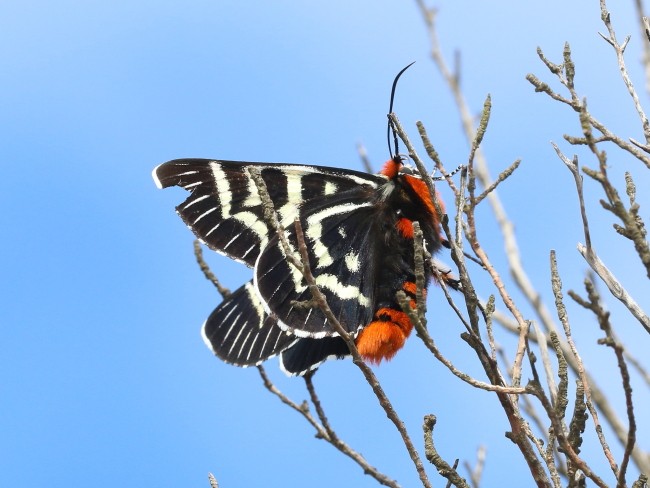
(Comocrus behri)
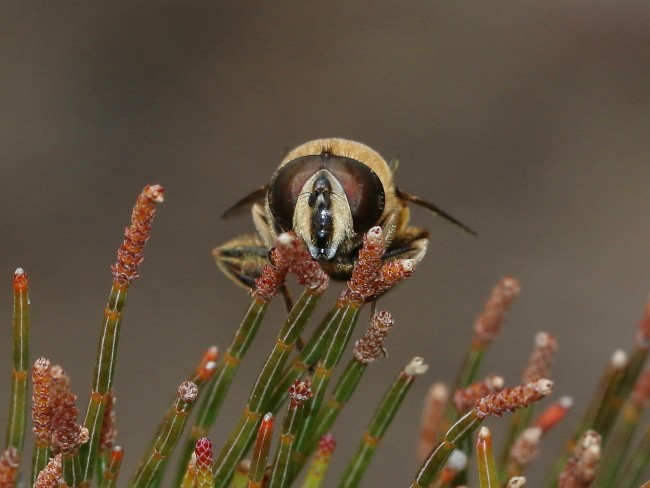
head-on view
Around 11am a couple of Tisiphone abeona (Swordgrass Brown) butterflies appeared, which was not unexpected. More surprising was the sight of a Hypocysta pseudirius (Grey Ringlet) who was labouring under the misapprehension that he belonged to a hilltopping species. I’ve seen pseudirius getting a bit territorial before, but this guy seemed to identify as a Hesperilla, zipping about as fast as he could and chasing away everything that moved.
A couple of Dispar compacta (Barred Skipper) eventually saw off the ringlet. This is an interesting little beastie with a Nike tick on the upperside of its forewing; I’m surprised Nike haven’t sued them for a trademark violation, though I suspect compacta was using that logo first. I was expecting to see compacta and so I spent a few minutes getting a couple of shots of them, my favourite being this underside view :
But that was just about it. One or two fresh Erina hyacinthina (Dusky Blue) flashed around for a while, and one large skipper zoomed about at lightspeed, preventing me from identifying him. There was no sign of myrmecophila, in fact there were no Ant Blues at all. Earlier in the season there had been a number of Acrodipsas aurata (Golden Ant Blue), settling at head height or lower on the bushes, and usually two or three A. brisbanensis (Bronze Ant-Blue) as well.
By midday, even though the sun had come out, the hilltop was still devoid of Acros and I decided to go down and try another nearby hill on the way back towards the station. I’d only been to that hill once – it hadn’t been especially productive on that occasion but I just had a feeling that the first hill wasn’t going to provide anything especially interesting that day.
The second hill proved a little more entertaining that the first. A few Theclinesthes miskini (Wattle Blues) were disputing perches near the peak of the hill, and I saw some Hesperids most of which turned out to be Mesodina halyzia (Eastern Iris-skipper).
A few Timoconia flammeata (Bright Shield-skippers) were also present, but I was only able to get one remotely half-decent photo. I’ve usually found this butterfly to be reasonably easy to approach, but those guys were so paranoid that I couldn’t get near to them.
An extremely large Delias harpalyce (Imperial Jezebel) spent a long time flying around close to the hilltop, but as is so often the case he didn’t even think about landing to pose for any photos. I tried telling him that he could appear on my website completely free of charge but he just wasn’t interested, which was a shame as I don’t have many photos of harpalyce.
I was not really holding out much hope for myrmecophila on this hill as the trees at the top are quite tall, and that’s where the myrmecophila would be if they were on the wing. I scanned the tree tops repeatedly but didn’t see anything moving, though that doesn’t mean they weren’t there because many Acros will sit still for long periods of time unless disturbed. It would have been nice to see them flying, even though there was no way I would get a decent shot of a miniscule butterfly sitting at the top of a 15 metre tree.
A search of the large shrub at the edge of the hill’s little plateau did reveal two male Golden Ant Blues, one of them being a very fresh specimen. I really don’t need more photos of male aurata as I have plenty, but I just find Ant Blues to be irresistible, particularly aurata. I snapped happily away for a while before noticing a mantis who was also keen on getting a few Ant Blues.
With nothing much else around I called it a day and hiked back to the station for the long train ride back to Sydney.
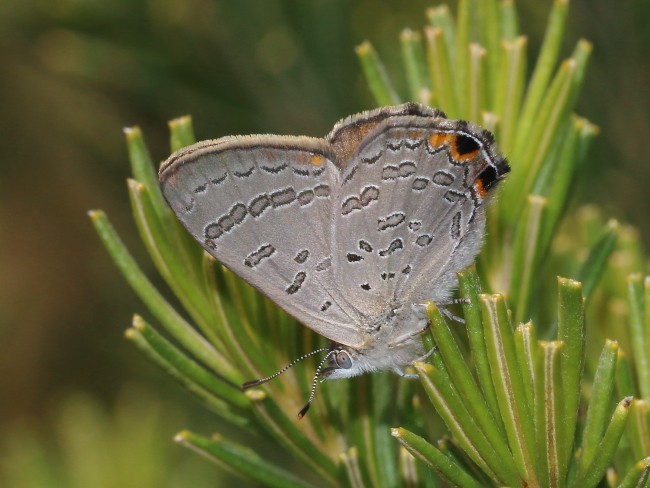
(Golden Ant Blue)
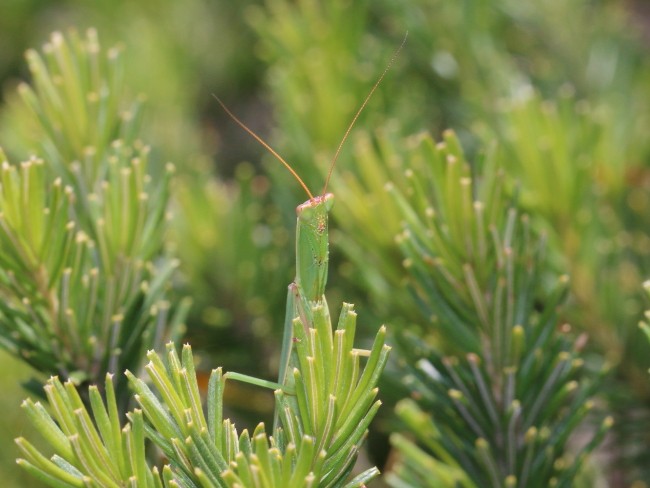
Looking for Ant Blues
Ingleburn – 11/03/2019
Ingleburn is where I first began photographing butterflies, as I found plenty of them in the reserve a few minutes’ walk from my home. I still go back there every year at the end of winter and/or early spring, as for some reason Paralucia aurifera (Bright Copper) and Candalides heathi (Rayed Blue) fly there earlier in the season than anywhere else I’ve been. They’re both very attractive species, and the sight of them always makes me feel as if the butterfly season is on its way.
I haven’t been to the Ingleburn site in the summer or autumn for many years, so this year I decided to give it a go and see what might be found. Unfortunately the answer turned out to be “Not much”.
As so often happens it was a lovely sunny morning, right up until I reached my butterfly location. Within a couple of minutes the clouds rolled in and stayed there. I walked many kilometres along the various tracks, but all I found were :
- One female Paralucia pyrodiscus (Dull Copper)
- A few female Paralucia aurifera (Bright Coppers). No males at all, which greatly surprised me as the males are usually much easier to find.
- One female Toxidia parvula (Parvula Skipper)
- One very fresh-looking Ocybadistes walkeri (Greenish Grass-dart); just about the greenest-looking specimen I’ve seen.
- Quite a few Leptotes plinius (Plumbago Blues) congregating around a Plumbago bush (no surprise there!).
- One extremely worn Trapezites symmomus (Splendid Ochre). He didn’t look very splendid to me.
- A couple of Theclinestes serpentatus (Saltbush Blues)
- A few Zizina otis (Common Grass Blues), one of which was a beautiful fresh male with a strong blue colour, which can’t be seen in my photo of him as he insisted on settling with his wings closed.
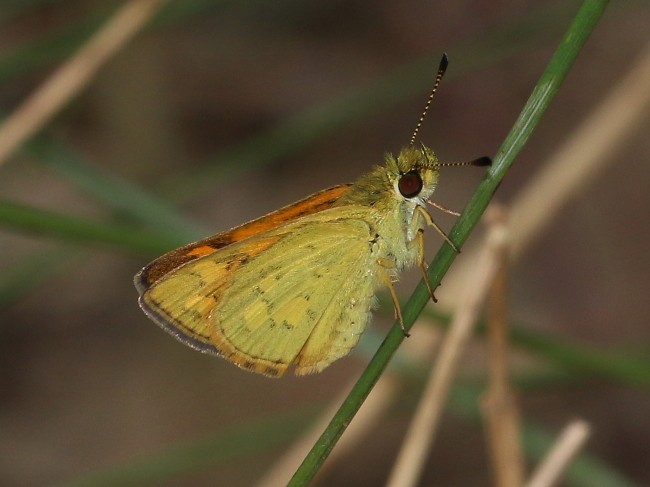
Greenish Grass-dart
Lawson – 26/03/2019
This trip to Lawson was made specifically to find one species : Heteronympha banksii (Banks’ Brown). It happened to be exactly 14 years to the day since I first photographed this species at the same location. I used to visit this site often in those days, as it was a good place to find interesting butterflies.
Within a couple of minutes of entering the North Lawson Park I found a male banksii who had set up a territory in a small clearing where I’d photographed my one and only Toxidia andersoni (Southern Grass-skipper) back in 2008. He was fairly tattered and a bit flighty, taking off if I came close, but I found that if I waited a couple of minutes before approaching he was much more likely to sit still while I took photos. However, I had to change my technique because banksii, like most of the larger Satyrids, doesn’t appreciate flash photography.
I generally use my camera’s pop-up flash when taking butterfly photos, as I’ve found that doing so with the aperture set to f-11 and ISO 200 is a useful default setting. If a butterfly deigns to let me get multiple shots then I will mess about with the settings to fine-tune the images. But some butterflies (notably some skippers) have a tendency to jump when the flash fires, resulting in a useless photo, whilst others fly off with alacrity as if the devil himself was after them. Heteronymphas are in the latter category, though curiously they don’t seem that bothered by the flash if they’re sitting with their wings tightly closed, only if they have their wings spread. I have no idea why this is the case.
I therefore closed the flash, and changed from Manual to TV mode (Shutter priority); I chose the shutter speed and ISO and the camera selected the f-stop for each shot.
Continuing along the track I reached the little raised area immediately before the gate into the Blue Mountains National Park. This serves as a hilltop of sorts and in the past I’ve found a fair few butterflies here, and it’s where most of my shots of banksii were taken in 2005. It was pretty dead there this time, with no sign of banksii at all, so I went around the gate and down the slope into the National Park.
About 50 metres down I disturbed another male banksii, in similar condition to the first. This guy led me a merry old dance up and down the track, as every time he took off he’d go for about 200m before settling on the track to bask in the sunshine. After many attempts to get close to him I finally got some shots, after which he became quite the poseur and refused to fly at all no matter how close I got to him.
Dragging myself away I proceeded down the track, which became quite steep, until it took a turn to the right and went into a more shaded spot. Here were 3 more banksii, two males and a female, and all in a bit better condition than those I’d seen higher up. The light conditions here were much more difficult than earlier, as these butterflies were settling in dappled light under trees, so I was having to change the camera settings for virtually every shot. I have to practice this sort of thing more, as I do need to be able to get better shots on those occasions where I can’t use the flash.
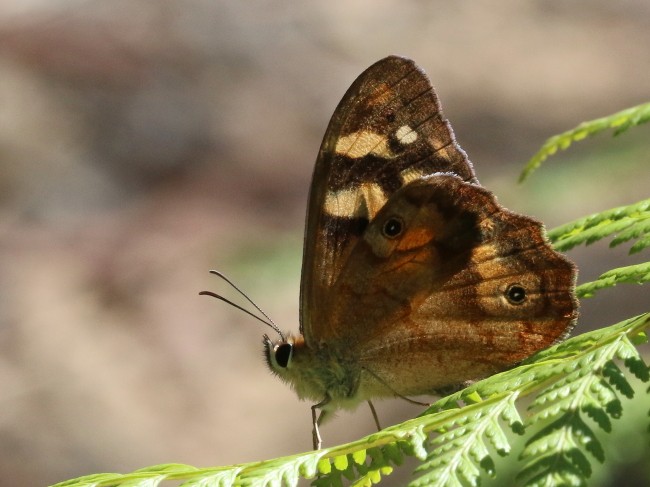
in awkward dappled light
I took a lot of photos of those banksii, until one of the males disappeared and the remaining two butterflies threatened to take out a restraining order against me. At this point I continued down the track and followed it down to where it crossed the Empire Pass Walking Track, then back up the other side (pretty damn steep in places!) until I reached Queen’s Road, hanging a left to go up to where it joined the Lawson Swamp Walking Track.
I followed this for a while along the edge of a small escarpment, until I reached a little hilltop where I’d found one or two interesting things in the past. It was deserted on this day, in fact I’d hardly seen a single butterfly of any kind since I parted company with that little group of banksii.
I traipsed around for an hour or so longer without seeing anything, then gave up and walked back down Queens Road to the Great Western Highway, and from there to Hazelbrook Station to catch the train home.
I had mixed feelings about the day. On the one hand I did find and photograph my target species, though the specimens were all damaged to a greater or less degree. But I was surprised and disappointed to see virtually nothing else on the wing. In recent years I’ve found Lawson to be much less productive than it used to be, so I’ve visited there less frequently. It’s a convenient site for me as it’s only a few minutes’ walk from Lawson station, so I hope the butterfly numbers there improve again in years to come.
Photos added to the Gallery in this update
- Heteronympha banksii (Banks’ Brown)
- Tisiphone abeona (Swordgrass Brown)
- Hypocysta pseudirius (Grey Ringlet)
- Acrodipsas aurata (Golden Ant Blue)
- Paralucia pyrodiscus (Dull Copper)
- Paralucia aurifera (Bright Copper)
- Erina acasta (Blotched Dusky-blue)
- Erina hyacinthina (Dusky Blue)
- Theclinesthes miskini (Wattle Blue)
- Theclinestes serpentatus (Saltbush Blue)
- Leptotes plinius (Plumbago Blue)
- Zizina otis (Common Grass Blue)
- Dispar compacta (Barred Skipper)
- Timoconia flammeata (Bright Shield-skipper)
- Toxidia parvula (Parvula Skipper)
- Ocybadistes walkeri (Greenish Grass-dart)

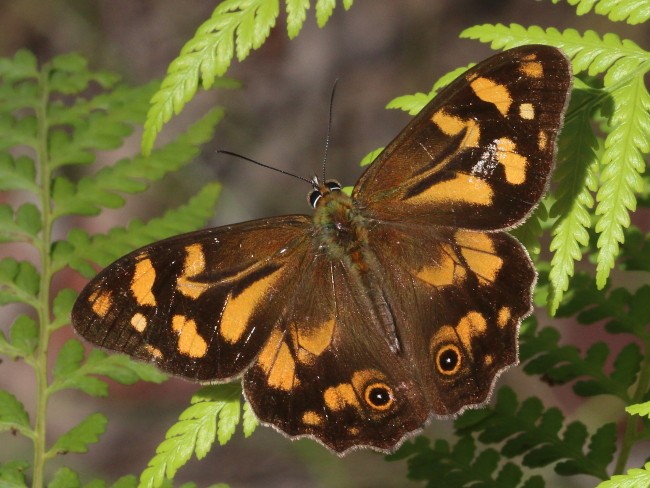
Fantastic result and pics , I dont know how you do it without a car , things are still flying here as it is still quite warm , and a few migrant are about , hope you get up here again before the end of the season
The weather’s been fantastic lately, but I’ve mostly been locked away in my Geek Room grappling with WordPress and making it work reasonably well with the hundreds of HTML pages and thousands of images I had in the previous version of my website. I still have more stuff to do, but for now the setup stuff is basically done, and now that I’ve processed my backlog of photos I’d like to get out with my camera in the next few days.
I just need to decide where to go. I was thinking of going to Glenbrook, but the site I went to last time (in the afternoon after going to Lawson) was as dead as I’ve ever seen it. Of course that was a month ago, so it might be different now.